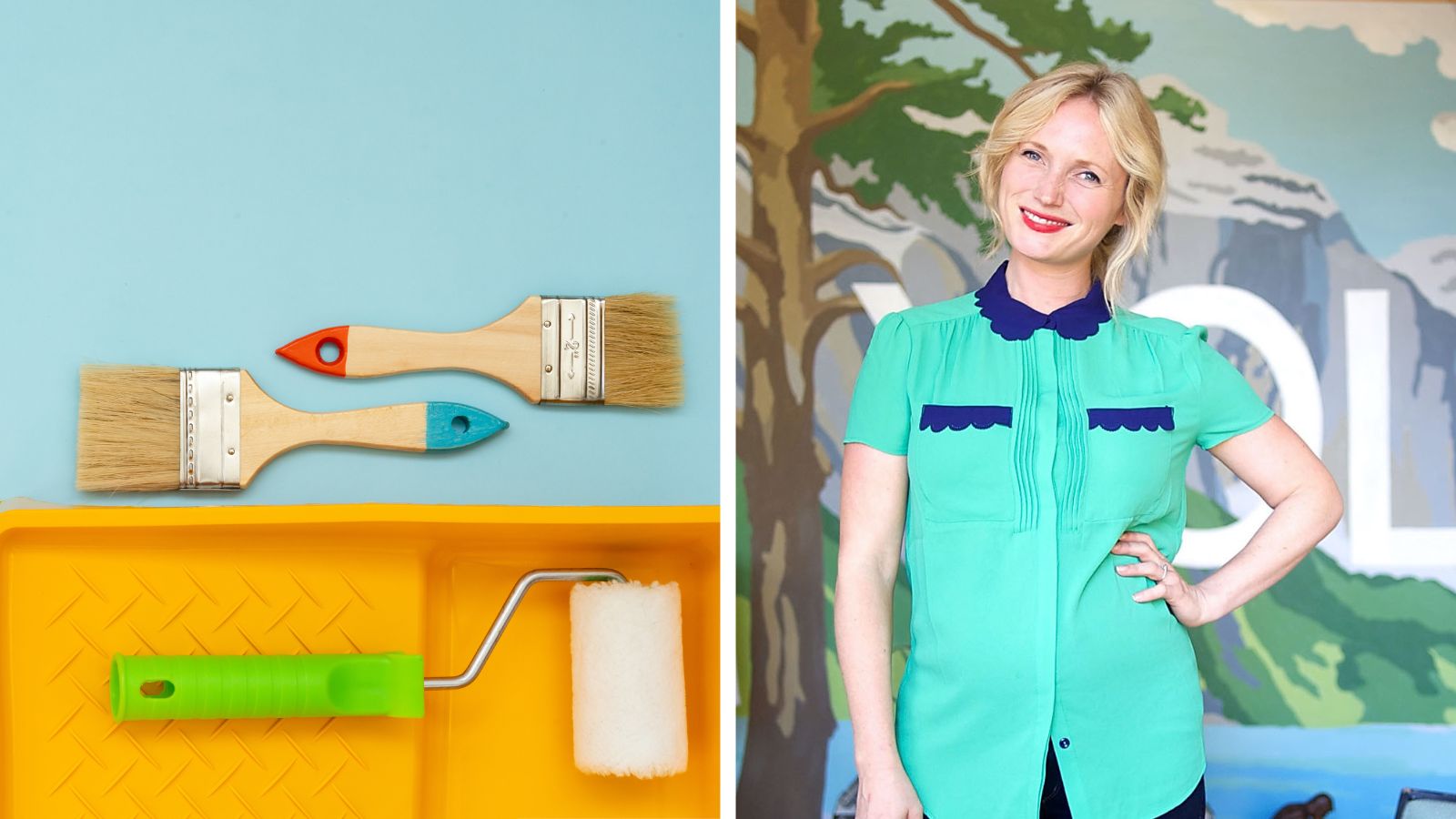This Emily Henderson wallpaper hack is renter-friendly perfection — bring it to life in your home in 4 simple steps
Experts shell out insight on the new Emily Henderson wallpaper DIY trick and bringing it to life in your rental space


A new Emily Henderson wallpaper hack has graced our social media feeds, and the renter-friendly method uses an unlikely source to zhuzh up walls: fabric.
Instead of traditional pasted or peel-and-stick wallpaper, the designer reveals how to transform any room with textiles, water, and starch, making it a damage-free way for renters to decorate their walls. Our experts reveal how to do it in four simple steps, plus the supplies you'll need to recreate this dreamy look.
While the best peel-and-stick wallpaper continues to serve renters well for style and damage-free results, now you can turn any print you love into statement wall decor.
See the Emily Henderson wallpaper hack in action
Gretchen Raguse, an Emily Henderson Design employee, decided to give this method a go when contemplating easy small bedroom upgrades.
She paired a moody green vintage floral print with zen pieces: a rattan headboard, blue bed sheets, and wooden nightstands. Her brass table lamp, similar to the Alden Décor Dome Iron Table Lamp from Bed, Bath, & Beyond, adds the perfect touch to her sleep space.
Watch below to see the easy small bedroom DIY project come to life.
A post shared by Emily Henderson (@em_henderson)
A photo posted by on
Instead of wallpaper and some sort of adhesive, use fabric and a water and starch mix to put up this renter-friendly small space DIY feature. You can later take it own damage-free, keeping your landlord happy, and your walls immaculate.
Get small space home decor ideas, celeb inspiration, DIY tips and more, straight to your inbox!
Exactly how to hang wallpaper varies depending on the type of wallpaper. Here's what you'll need to go the fabric DIY route, like Emily Henderson and her team:
Supplies you'll need
- A lightweight textile of your choice
- Fiskars Scissors 8" Bent Right-Handed Scissors from Walmart
- Edward Tools Hand Paint Roller and Cover 9” from Amazon
- Purex Sta-Flo Concentrated Liquid Starch, 64 oz from Amazon
- Sterilite 8 Qt. Plastic Dishpan from Walmart
- Amazon Basics Tape Measure 16' from Amazon
- 4' x 15' All Purpose Canvas Drop Cloth by CCS CHICAGO CANVAS & SUPPLY from Amazon
Step 1: Prep your space
Clear out any furniture that will get in the way of you reaching the walls you're working on and lay down painters sheets or drop cloths to protect your floors and belongings from drips. Remove dust, cobwebs, and any loose debris from your walls. A HBTower Step Ladder, 2 Step Stool from Amazon might come in handy for tricky corners.
Prep your tools: you'll need a tray for your combo of liquid starch and water, a paint roller, painters tape to hang the fabric (a stapler works too, but will leave permanent marks), a measuring tape to plan out each panel's size, fabric scissors to cut, and a spray bottle filled with your liquid mix -- if any parts of the wall look a little bubbly throughout the application process, spray the mix to smooth things out.
As fun as it might be to select colorful patterns and interesting designs, do keep in mind that the type of fabric you work with is important.
"Select lightweight textiles to make it easier when applying them on the walls," says designer Artem Kropovinsky. "Also they should be in line with the design and lighting of the room."
Step 2: Measure and cut your fabric
Start by measuring your wall, then cutting the appropriate sized panels from your chosen fabric, making them a bit longer than necessary. You can trim them later for a perfect fit as we all know walls and floors are rarely super straight.
If you want the fabric to be super flat and wallpaper like, steam-iron your panels to get any creases out (the BLACK+DECKER Steam Iron with Retractable Cord from Target will do nicely).
"Of course like any wallpaper, make sure the walls are clean, smooth, and patched up if there are any holes before application," says designer Chantelle Hartman Malarkey. "Make sure your lines are cut straight, or else the eyes will always be drawn to the imperfection."
Step 3: Mix paste and hang
The next step for this bedroom wallpaper idea is hanging the fabric. Use painter's tape to temporarily place your fabric in the proper position.
Mix the paste (an adhesive-free combination of half water and half liquid starch), and use a roller to paste over the top of the fabric, leaving your walls untouched. The amount needed will vary depending on the size of your wall, so grab an extra bottle if you're working with a lot of space. According to Emily and her team, you can rolling directly on top of your dry, hanging panel, provided the fabric you're working with is not too thick.
"Using fabric as wallpaper creates an incredible and unique aesthetic to any room," says Antonia O’Hara Founder of Indigo by Boutin. "We suggest using liquid starch to install in order to easily change it down the road if you ever want to switch up the design."
And as far as styling, Antonia is all about the bright, bold route.
"I think using a bold fabric, preferably a block print design really allows it to take over the room," she adds. "From there you can use more neutral pieces so that the room does not look too overwhelming."

Antonia O’Hara, the visionary Founder of Indigo by Boutin, where masterful artistry meets ethical luxury in the realm of fashion and interior design. As a seasoned world traveler with a deep passion for textiles, Antonia's journey to becoming a global tastemaker was sparked by her enchantment with India's exquisite crafts and skilled artisans.
Step 4: Tidy up panels
Once your fabric wallpaper paste has dried and the panels secure, use scissors to cut away any excess and remove the painters tape that had been holding things in place. Your fabric wallpaper should stay firmly put.
Make sure to open windows and put on fans during the drying process, which should take several hours, but to be extra certain everything is in place properly, Emily and her team suggest waiting about a day. Use a trimmer to cut away any excess fabric or fabric that goes over switches, windows, etc.
When all is said and done and you're ready to move, simply pull the wallpaper/fabric off the wall and enjoy a clean wall, keeping landlords happy. If you're curious, Emily says the panels of fabric can be used again.
Looking to get even more creative with your wallpaper? Allow our DIY experts to assist. They'll instruct you on how to use peel-and-stick wallpaper for a major furniture upgrade and how to tackle out-of-the-ordinary wallpaper project ideas to make a statement.

Pleasure to meet you! I'm Danielle, a content editor at Real Homes who loves scoping out interior trends. I've specialized in lifestyle writing and editing for 10 years with a focus on events, food, and books, among other areas. When I'm not working, I'm usually cooking, reading, or searching for a new project for my apartment.

